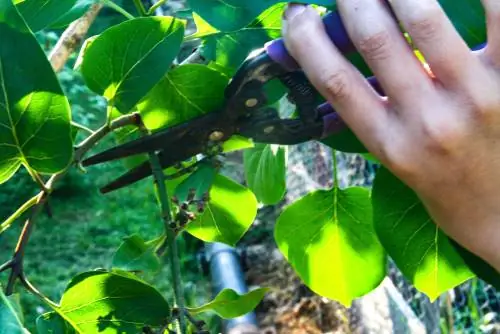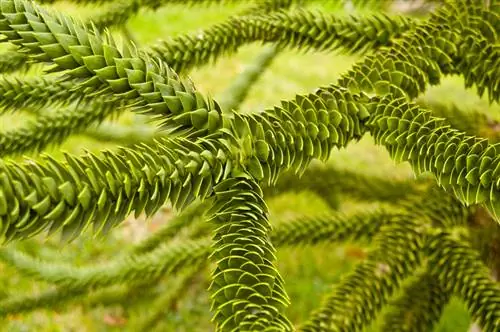- Author admin [email protected].
- Public 2023-12-16 16:46.
- Last modified 2025-06-01 06:02.
With its crown flooded with light, the flowering wood in the lilac tree remains vital for up to 20 years. Reason enough to thin out old, dead and balding wood every few years. These instructions get to the heart of when and how to properly cut lilacs as a standard tree.

How do I prune a lilac tree correctly?
To prune a lilac tree correctly, you should thin out the tree crown in late winter, remove dead branches, shorten disturbing shoots and loosen compacted areas. Withered flowers are removed after the flowering period, runners and stem shoots should be removed regularly.
The best time to prune is in late winter
The optimal time window for a thinning cut on the lilac tree opens in late winter. When the leafless winter rest comes to an end, older specimens also tolerate a regular cut within the crown. Choose a dry, cloudy day with temperatures above freezing.
Thinning out the treetop - this is how it works
Over the years, the crown of the lilac tree develops into a network of old and young branches. Without occasional pruning, the shoots shade each other. As a result, the center of the crown becomes bare, while branches in the outer sectors grow ugly with unsightly ramifications. By carrying out a thinning cut every three to four years, you can prevent the nuisance. How to do it professionally:
- Saw off dead, bare branches on Astring
- Cut back cross-growing and other disturbing shoots by up to two thirds
- Tie down or cut off tightly upright shoots
- Remove the weaker branches from branches that are too close together
If you are struggling with overly long shoots that protrude from the crown shape, a derivation cut will solve the problem. Instead of cutting at a bud, choose a young side shoot that faces outwards as the cutting point. Lilacs bear their most beautiful flowers on one- and two-year-old branches, so that thanks to a derivation there is neither a gap in the crown nor this year's flowering is affected.
Cleaning up wilted flowers
The most common reason for cutting a lilac tree is withered flower candles. If you find the dead lilac flowers a nuisance, there is nothing wrong with a light pruning at the end of the flowering period. The cut requires a good sense of proportion because the flower wood for the next year's lilac blossom is already forming beneath the withered flowers.
Take a pair of sharp, clean secateurs (€9.00 on Amazon) with a bypass mechanism. Place the blades below a spent panicle, a short distance from a pair of leaves.
Remove runners and trunk shoots
The most beautiful lilac trees thrive as a combination of the robust trunk of a wild species and a noble crown. Apart from the many advantages, such a refinement is associated with the growth of numerous runners and trunk shoots.
Stay on the trail of the wildlings as soon as possible. The vigorous wild shoots can be recognized by a different leaf shape than the crown leaves. Tear off root runners with a strong tug to remove as much tissue as possible. Cut off stem shoots just short of the bark.
Tip
Have you inherited an old lilac tree or an old lilac bush? Then you can bring the ornamental tree into shape with a rejuvenating cut. At an advanced age, lilacs can easily cope with radical pruning if you spread the measure over three years.






